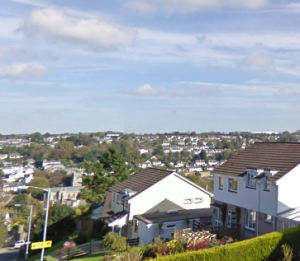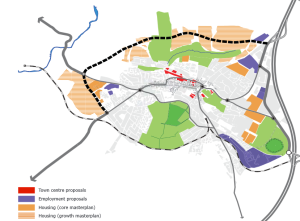Back in the late 1960s when we were all poor, existing on a diet of stale saffron buns and living in hovels, Bodmin became the site of a social engineering experiment. An injection of a new ‘overspill’ population from London would revive the town, which had lost its way since the main railway line carefully avoided it in the 1850s.
In the last half-century Bodmin has indeed been the fastest growing town in Cornwall. Its population increased by 137% while the population of Cornwall as a whole ‘only’ grew by 58% (or around four times faster than in England). As it happens, Bodmin’s growth rate hasn’t been that much higher than Helston, Wadebridge, Saltash or Liskeard. Even before the ink was dry on Bodmin’s Faustian pact, unplanned market-led growth had become the County Council’s de-facto, though rarely publicised, high population growth strategy of choice.
But apparently, even this growth rate hasn’t been enough. In 2012 Cornwall’s planners detected that ‘Bodmin has aspirations to grow in terms of both housing and employment’. That was most convenient news for Cornwall Council’s Tory/Independent administration, gung-ho for ‘growth’. Already, two years earlier, it had commissioned its favourite pet consultants, GVA Grimley, commercial property agents (nearest office Bristol) and NEW Masterplanning (of Poole, not Pool), to propose a ‘Masterplan’ for Bodmin.
Carefully considering the failure of the high-growth strategy since the 1960s, the masterdisaster planners came up with a ‘radical’ plan. This was one that listened to ‘the message from local residents’. It concluded that ‘Bodmin needs to change … shops, leisure facilities, jobs, housing and transport infrastructure are all needed’. Which, given GVA Grimley’s business as commercial property managers and its role as lobbyists for business, might seem a rather useful conclusion to draw.
Bodmin apparently needed to be dragged out of the horse and cart-age stagnation in which it was stubbornly snoozing. Completely re-writing its history of rapid population growth since the 1960s, the consultants concluded that Bodmin needed to abandon its slumber and join the modern world. What it required was something new. Let’s see, how about a lot more houses for a lot more people? Hopefully, this would create a lot more shops and a lot more jobs.
The ‘radical’ plan transpired to be a huge anti-climax. On closer examination, it was just the same old thing, basically a strategy of build a hell of a lot more houses and cross your fingers.
The original plan – funded by £341,000 of European grant money incidentally – contained a core strategy and a ‘growth’ strategy. Actually, both were growth strategies. But the ‘growth’ growth strategy proposed building 6,000 houses within a generation, thus doubling the size of the place. Since then, this has been scaled back to a mere 3,000 by 2030. Unfortunately for Bodmin, that’s still a 46% growth rate. This considerably bumps up even its previous high rate of growth – and is easily the highest growth rate in Cornwall.
The lucky folk of Bodmin are set to watch a lot of the nearby fields disappear to the east, south and the north of the town. Although the even luckier developers set to benefit from this bonanza have yet to come up with many concrete proposals.
 This amazingly novel strategy, complete with the usual ‘sustainability appraisals’, was ‘unanimously approved’ by Cornwall councillors according to the press. Local councillors Ann Kerridge (Lib Dem) and Pat Rogerson (Lib Dem), having learnt nothing since Bodmin’s town councillors opted for overspill in the 1960s, both welcomed the original plan and its 6,000 houses with open arms.
This amazingly novel strategy, complete with the usual ‘sustainability appraisals’, was ‘unanimously approved’ by Cornwall councillors according to the press. Local councillors Ann Kerridge (Lib Dem) and Pat Rogerson (Lib Dem), having learnt nothing since Bodmin’s town councillors opted for overspill in the 1960s, both welcomed the original plan and its 6,000 houses with open arms.
Presumably, as more than doubling the population in 50 years didn’t work, the idea is to increase the growth rate to 50% or so in just 20 years. And if that doesn’t work either? How about doubling it in 10 years?
But why stop there? Let’s go the whole hog. Let’s recognise the wishes of Bodmin’s representatives for the town to become Cornwall’s growth centre. Why not stop building elsewhere and divert it all to Bodmin. Bodmin’s population would then reach 100,000 by 2030. It could be a special population growth heritage site, a laboratory at the cutting edge of the growth strategy – the glittering symbol of Cornwall’s future, blazing a trail while other communities looked on with envy.
In the 1960s Bodmin Town Council only agreed the overspill plan after a protracted and heated campaign of opposition had been beaten off. Is this likely to emerge again this time around, as the distant rumble of the JCBs begins to be heard in the town?
Meanwhile, GVA Grimley was bought by German company Bilfinger earlier this year. GVA was ‘highly profitable’, said the Germans.


